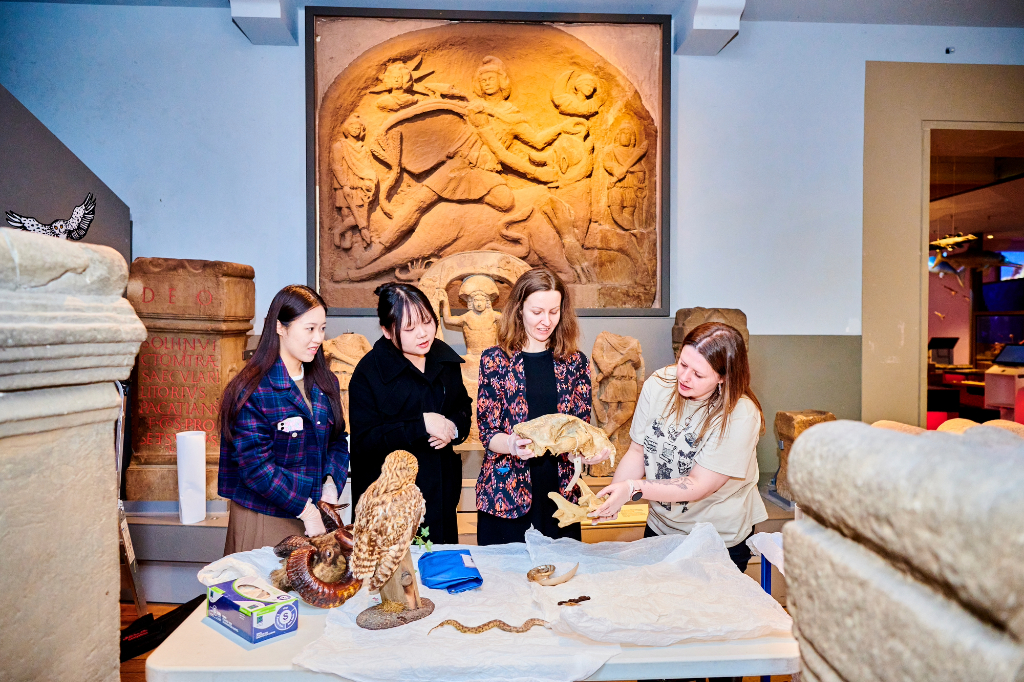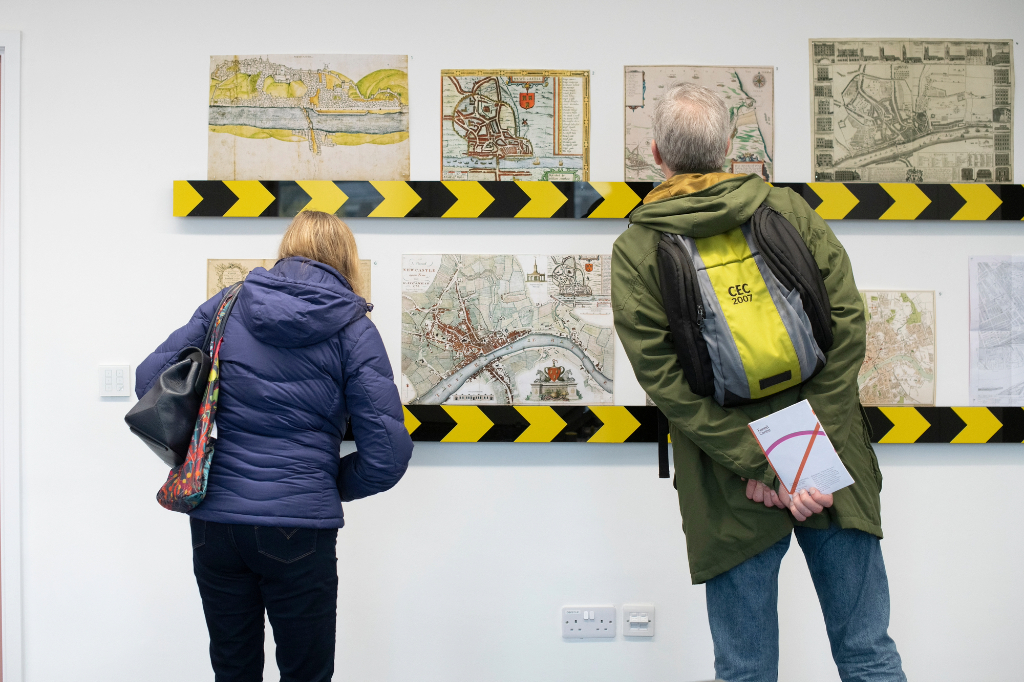Thinking about the University Museums and Galleries of the Future
6 October 2023 | By: Professor Vee Pollock | 3 min read
What’s the significance of University Museums and Galleries (UMGs) in the cultural, university, and museum sectors?
Our Dean of Culture and Creative Arts, Professor Vee Pollock, explains the current landscape and the impact Newcastle University’s UMGs have on the wider research, skills development, engagement, and collaboration fields.
Contents:
University Museums and Galleries (UMGs) are a distinctive component of our cultural sector. They bring together significant and often designated collections with world-leading research and make that accessible to academic and diverse public audiences.
As part of both the Higher Education and Museum sectors, they act as an interface, enabling multiple interactions that shape and challenge our understanding of the world in which we live.
At Newcastle University we are fortunate to have three of our own cultural venues on campus:
- Great North Museum: Hancock (GNM:H) – a distinctive partnership led by the University in conjunction with the Natural History Society of Northumbria (NHSN), the Society of Antiquaries of Newcastle upon Tyne (SANT), and Tyne & Wear Archives & Museum (TWAM) who manage the Museum on behalf of the partnership. It holds significant collections owned by the learned societies and the University. This includes the largest and most diverse Natural Sciences collections in any non-national institution in Europe, and internationally important archaeology from the Hadrian’s Wall World Heritage Site. It has Newcastle University research informing all aspects of its learning programmes and at the heart of many displays.
- The Hatton Gallery – dating back to 1912, the Hatton Gallery sits within Fine Art at Newcastle University and has a significant history relating to the development of pioneering pedagogy in creative arts (particularly the ‘Basic Design’ course), the practice of exhibition-making, and the emergence of immersive installation. Amongst its collection are works by Francis Bacon, Richard Hamilton, Prunella Clough, as well as Kurt Schwitters’ Merz Barn wall - the last of his ‘merz’ pieces - which is on permanent display in a purpose-built installation space.
- The Farrell Centre – having opened in 2023, the Farrell Centre is the newest of our cultural venues. Instigated by the renowned architect, Sir Terry Farrell, its mission is to widen the debate around the crucial roles that architecture and planning play in the contemporary world in ways that are engaging, innovative and challenging. It is closely linked to Newcastle University’s School of Architecture, Planning and Landscape, and also draws from the Sir Terry Farrell archive - looked after by the University’s Special Collections.
UMGs are an integral part of what the University does across teaching, research and wider engagement - working regionally, nationally, and internationally.

Group working in the Great North Museum: Hancock
Unlocking research
As a hub for interdisciplinary and multidisciplinary thinking, UMGs are a space for experimentation. They advance knowledge through collections-based research that often links to and questions how we think about global, environmental, and societal challenges. For example, when Dippy the Dinosaur came to GNM:H, the exhibition and learning programme concentrated on the climate emergency which was informed by cutting-edge Newcastle University research.
It's not only the collections that are held which are the subject of research, but also museum practices. In the Great North Museum's Living Planet gallery, visitors are invited to step into the interactive Story Inspiration Station. Created by Open Lab at Newcastle University’s School of Computing, visitors can pull the lever to reveal different objects from the Museum’s natural history, archaeology, geology, and global collections, and tell their own story about them.
Whether it be as a catalyst for research, a partner in research, or as a means to bring specialist public engagement skills to the dissemination of research, UMGs are a key partner.
Enabling skills development
Students benefit from ‘real world’ skills development by working with our UMGs on a range of projects. Some modules are embedded within UMGs - using their collections or engaging in their processes - while other students engage through bespoke opportunities linking to specific exhibitions.
Whether it be creative writers responding to paintings, geography students working with community groups, or dancers choreographing works in galleries in response to displays, imaginative engagement with and through our UMGs enriches the student experience.

Couple observing maps in the Farrell Centre
Imaginative engagement
UMGs are often an open door to campuses and universities for a diverse public, supporting widening participation, relationships with place, and community engagement. They work with a wide range of partners and stakeholders to convey university research in a way that enriches experiences for all visitors.
For example, recently at GNM:H, partners and researchers from Newcastle and Portsmouth came together to develop a sound-based educational planetarium show that sought to make learning about the universe a more immersive and inclusive experience, particularly for visually impaired visitors.
Additionally - integral to the Farrell Centre - is the concept of an urban room, which seeks to engage people in discussions about the architectural and urban issues that impact their lives. In this way, UMGs are catalysts for debate which in turn influence research, teaching, and the ways our UMGs work.
Collaboration
Across all areas of their work, UMGs are natural collaborators - developing research with their host institutions and other universities across the globe, working across networks of UMGs and GLAM (Galleries, Libraries and Museums) sectors, and drawing in a range of wider partners.
This ability to work in an agile and informed way - to pull together diverse constituents to become greater than the sum of its parts, and to advance not only knowledge but also museological and education practice - is what makes UMG’s powerhouses within the University and Museum sectors.
The future
The value of culture, creative arts, and heritage has been widely debated in various spheres - be it education, diversity and inclusion, or government policy. UMGs have a tricky position in this landscape. Certain funding streams are inaccessible to them due to their dual status. Amidst competing priorities, their contribution and importance can be overshadowed due to their sheer breadth, and as with many creative endeavours, their transformative impact can be difficult to articulate.
But the UK Government’s plans to boost the creative industries and recognition of this as one of the UK’s fastest growing sectors - coupled with the North of Tyne Combined Authority’s Culture and Creative Investment Programme – means that this is potentially a promising time, with policymakers starting to think more creatively around the potential of culture, particularly within our Northern region.
With a changing research and education landscape (particularly for culture), we need to continue to be creative in the way universities work with UMGs to embed core teaching and research initiatives to respond to future educational and skills needs. There is huge potential here to advance UMGs as spaces of possibility, of risk, of experimentation, of collective endeavour, and transformative impact.
You might also like:
- Discover the University’s position and work in Culture and Creative Arts
- Find out more about Professor Vee Pollock, her research, teaching, publications and more
- Learn more about The School of Arts and Cultures and their world-leading research and practice
- Make a day of exploring Newcastle University’s UMGs and cultural partners - explore the itineraries
.
